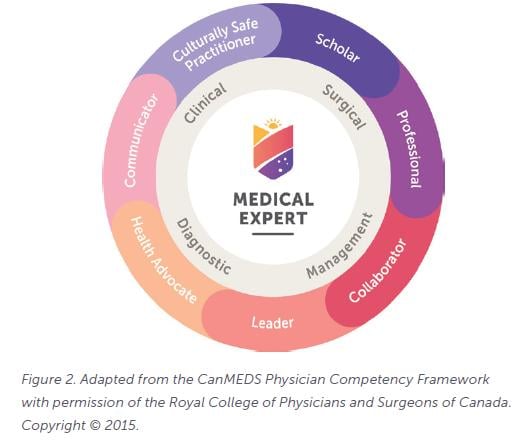Why change now?
Over the last 40 years there has been an evolution in the role of the medical colleges responsible for specialist training in Australia and New Zealand, from a largely examination setting focus to increasing involvement in the delivery of education and setting standards for training sites. At the same time there has been a shift in defining the expected learning outcomes for training from a “syllabus” of topics to be covered to competency-based curricula articulating what a trainee should actually be able to “do” by the end of training.
One of the most significant changes in training to have taken place in the last five years in Obstetrics & Gynaecology has been to introduce a much more structured approach to advanced training, recognising for the first time the concept of ‘streaming’ in specialist training outside of subspecialities. We now have options for trainees to focus on a career path to mainly obstetric-only care, sexual and reproductive health, or academic O&G, or to upskill in a particular area as part of generalist training.
The current RANZCOG curriculum was originally introduced in 2003. It divided learning outcomes into three areas; Clinical Expertise, Academic Abilities and Professional Qualities. Its focus was mainly on the first four years of training, and although the College subsequently developed a statement of the attributes of a new Fellow, this was not included in the curriculum. Each subspeciality developed their own curriculum documents. Although updated in 2009 and again in 2013, changes in clinical practice and training over the last decade meant there was a need to review the entire curriculum to make sure it remained fit for purpose.
The process
The curriculum review process began with the formation of the Curriculum Review Expert Advisory Panel (with the somewhat unfortunate acronym of CREAP) in 2018, comprising Fellows and trainees with a background in medical education and expert external educational consultants from the Australian Centre for Educational Research (ACER). Over the next 18 months the group reviewed contemporary practice in curriculum design in higher education as well as the evolving landscape in clinical practice and training. The panel identified a number of issues with the existing program including the restrictions imposed by working within only three domains, the lack of consistency between different RANZCOG curricula, differences between curriculum and handbook, and a lack of distinct learning outcomes for Advanced Training. The working party developed a series of principles for the redevelopment of all training programs which were endorsed by Council in 2021
Initially it was decided to focus on the core curriculum for FRANZCOG specialist training with a view to then using this as a common template for all RANZCOG training programs, including Subspecialty and Diploma training. Responsibility for development of the new program was given to the Curriculum and Assessment Steering Group, and the completed draft program approved by Council in 2023.
- Single common format for curricula of all RANZCOG training programs.
- Adoption of the CanMEDS format for curriculum.
- Curriculum to include advanced as well as core training.
- Learning outcomes defined separately for end of basic advanced training.
- Basic Sciences Knowledge integrated into relevant medical expert topic sections.
- Procedural skills defined in terms of entrustability at the end of year 2 and advanced training as well as at the end of Core/Basic training.
- Clear linkage between overall graduate attributes, program learning outcomes and the details competencies needed to achieve these.
- All learning outcomes to be linked to one or more learning opportunities and modes of assessment.
- The use of simulation-base education and assessment be included in the curriculum.
- The curriculum to be available as a digital searchable document accessible though mobile devices.
CanMEDS and CSKIP
An early decision in the process was to adopt the curriculum structure based on that of the CanMEDS Physician Competency Framework (Frank et al, 2015). This divides the competencies needed for medical practice into seven ‘roles’ or domains based around a central Medical Expert role. This format has been widely adopted for both undergraduate and postgraduate curricula because it more clearly delineates those aspects of professionalism that were previously grouped together in the single “Professional” domain. A unique eighth role of cultural safety was then added to reflect the specific emphasis on this aspect in practice in Australia and New Zealand

The second design change to be introduced was unique to RANZCOG and related to the different topic areas that made up the larger Medical Expert Role. This was the Clinical Skills and Knowledge in Practice structure (CSKIP). As well as distinguishing clinical and “assumed” basic science knowledge this allowed a definition of procedural and non-procedural skills relevant to each topic (antenatal care, intrapartum care, gynaecological surgery etc) that were the key elements supporting the competencies for those topics.
Procedural skills
Reductions in the need for benign gynaecological procedures, reduced training hours and the recognition that not all Fellows would practice a full range of obstetrics and gynaecology after training forced us to recognise that gynaecological procedure training should be focused on those whose practice would most need this. The definition of the minimum common scope of practice has evolved to cover those surgical skills needed to manage complex obstetrics and emergency gynaecology only.
The new curriculum uses the language of entrustable professional activities for procedural skills (ten Cate, 2005). This now describes the expected level of supervision expected for different procedures not only at the end of Basic and Advanced Training, but for the first time draws a distinction between the first and last two years of Basic Training.
New ways of learning
Rapid development of online resources for learning and assessment was forced on us by the COVID-19 pandemic. The challenge is no longer access to learning resources but how to curate these and integrate them into training. Declining opportunities for experiential learning have focused renewed attention on simulation-based training and there is growing evidence that it improves patient outcomes (Dillon , 2021). However, the value of simulation is not limited to procedural skills – indeed its role in developing and assessing teamwork skills and managing complex but rare emergency situations will be just as important (Merchant, 2012). We have tried to reflect these trends by incorporating both simulation and eLearning in the new curriculum.
Assessment
While the College examinations enjoy a reputation with both trainees and examiners as being generally fair and valid, they still largely only assess what trainees say they would do rather than assessing what they actually do in real clinical settings. In response to this there has been a shift towards a more programmatic approach, where decisions about progression in training rely on multiple assessment instruments and assessors as well as increasing emphasis on workplace-based assessment tools (van der Leuten et al 2018). While high stakes examinations will continue to be part of this process, the new curriculum envisages greater focus on workplacebased assessment with the progressive introduction of well validated instruments such as mini-clinical evaluation exercise (mini-CEX), multisource feedback and case-based discussion over the next five years to supplement existing tools such as APSS and 6 monthly assessments (Norcini et al , 2003. Lockyear, 2003).
Future work
Subject to feedback from a range of external stakeholders, the new curriculum will apply to trainees entering Basic Training starting in 2024 and to other trainees (and examinations) from 2025. Work is currently underway to develop a fully device agnostic digital version of the curriculum which will allow trainees, exam coordinators and external stakeholders to search for any topic, competency, or assessment within the program.
Although addressing the core competencies expected from any FRANZCOG, every trainee will in practice have a wider but unique scope of practice reflecting the changes in Advanced Training into having a number of different pathways. Each of these will have their own ‘curriculum’ which will add additional knowledge skills and procedures (or more advanced levels of competence in these) to those of the core curriculum. The next stage in the project will involve completing the curriculum documents for the subspecialities and the Advanced Training Pathways.
Conclusions
Curriculum design in the face of rapidly expanding knowledge and changing clinical practice is challenging. We must not only ensure that what we teach today is relevant to contemporary clinical practice but somehow anticipate what that will look like in the future. This can no longer be accomplished by one major revision every 10 years but rather by having curriculum as a “living” document updated as needed. To paraphrase a quote often (but probably wrongly) attributed to Charles Darwin in Origin of the Species
“It is not the most intellectual of the species that survives: it is not the strongest that survives; but the species that survives is the one that is able best to adapt and adjust to the changing environment in which it finds itself”.
Acknowledgement
RANZCOG acknowledges the permission granted by the Royal College of Physicians and Surgeons of Canada to adapt and embed the CanMEDS framework in the FRANZCOG curriculum.






Leave a Reply